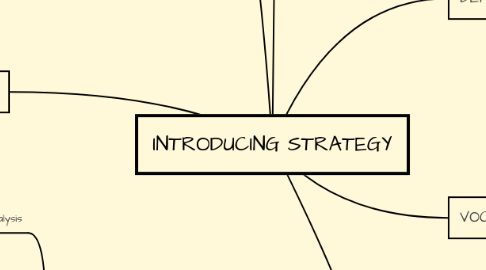
1. LEVELS
1.1. CORPORATE: purpose & scope of buss. to meet stakeholders expectations
1.2. BUSINESS: how buss. competes successfully in market
1.3. FUNCTIONAL: delivering corp. & buss. unit level strategic direction (implementation)
2. STRATEGIC MANAGEMENT PROCESS
2.1. Strategic analysis
2.1.1. environment
2.1.1.1. opportunities
2.1.1.2. threats
2.1.2. resources + competencies
2.1.2.1. strength
2.1.2.2. weaknesses
2.1.3. level of stakeholders influence
2.1.3.1. Mendelow matrix
2.2. Strategic choice
2.2.1. base to guide future strategy
2.2.1.1. stakeholder influence
2.2.1.2. competitive advantage
2.2.2. generating options
2.2.2.1. geographical area
2.2.2.2. business structure
2.2.2.3. growth
2.2.3. evaluating options
2.2.3.1. strength/weaknesses
2.2.3.2. opportunities/threats
2.2.3.3. environment
2.2.3.4. stakeholders
2.3. Strategy implementation
2.3.1. structure of organisation
2.3.2. planning of resources
2.3.3. management of change
3. DIFFERENT ORGANISATIONAL CONTEXT
3.1. size
3.1.1. small businesses
3.1.1.1. single markets
3.1.1.2. limited product range
3.1.1.3. strategic issues
3.1.1.3.1. large competitors
3.1.1.3.2. limited financing opportunities
3.1.2. multinationals
3.1.2.1. many diverse markets
3.1.2.2. wide product ranges
3.1.2.3. strategic issues
3.1.2.3.1. control of diverse business
3.1.2.3.2. resources allocation to business units
3.2. type
3.2.1. public sector
3.2.1.1. significant government influence
3.2.1.2. drive by political condition
3.2.1.3. strategic issues
3.2.1.3.1. role of ideology
3.2.1.3.2. competition for resources
3.2.1.3.3. limited funding
3.2.2. not for profit
3.2.2.1. non financial objectives
3.2.2.2. strategic issues
3.2.2.2.1. role of ideology
3.2.2.2.2. competition for funds
4. DEFINITION
4.1. Direction & scope of activities over LT
4.2. achieves advantages in changing environment
4.3. through resources + competences
4.4. fulfilling stakeholders expecattions
5. VOCABULARY
5.1. Mission: Main purpose
5.2. Vision: aspiration of company
5.3. Goal: General aim
5.4. Objective: quantification of goal
5.5. Competences/capabilities: resources for competitive advantage
5.6. Business model: flow, product & services info.
5.7. control: monitoring actions
6. STRATEGY LENSES
6.1. Design
6.1.1. rational
6.1.2. logical process
6.2. experience
6.2.1. past experince
6.2.2. influence by culture & wisdom
6.2.3. existing strategies
6.3. ideas
6.3.1. innovation from everyday jobs
6.3.2. changing circumtances
6.4. discourse (language)
6.4.1. strategic problem
6.4.2. strategy proposals
6.4.3. debate issues
6.4.4. communicate strategic decisions
